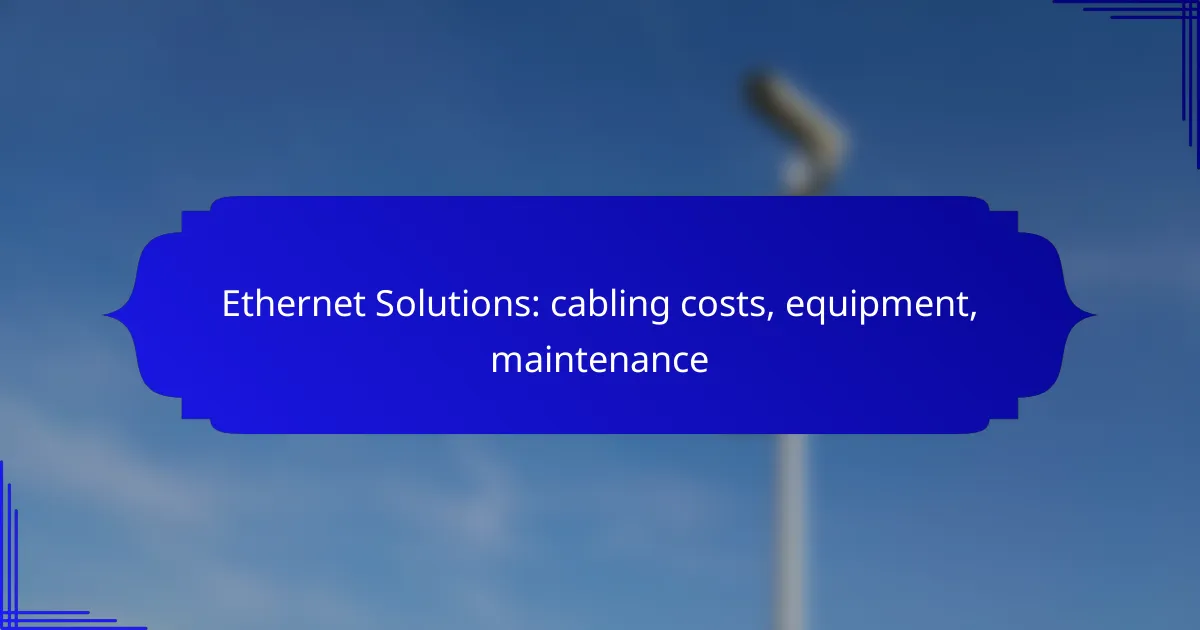Ethernet solutions are essential for establishing reliable network connectivity, with costs influenced by cable type and installation needs. Key components such as routers, switches, and patch panels are vital for optimal performance, while regular maintenance and organization of cables help ensure the longevity of the network infrastructure.

What are the Ethernet cabling costs in New Zealand?
Ethernet cabling costs in New Zealand vary based on the type of cable used and installation requirements. Generally, prices can range from moderate for standard copper cables to higher for advanced fiber optic solutions.
Cost of Cat5e cabling
The cost of Cat5e cabling in New Zealand typically ranges from NZD 0.50 to NZD 1.50 per meter. This type of cable is suitable for basic networking needs and supports speeds up to 1 Gbps over short distances.
When considering Cat5e, factor in the overall length required for your installation, as longer runs will increase material costs. It’s a cost-effective choice for small offices or home networks.
Cost of Cat6 cabling
Cat6 cabling is priced between NZD 1.00 and NZD 2.50 per meter in New Zealand. This cable type offers better performance, supporting speeds up to 10 Gbps for distances up to 55 meters.
Investing in Cat6 is advisable for environments with higher data demands, such as businesses that rely on fast internet connections for multiple devices. The initial cost is higher, but it can provide better future-proofing.
Cost of fiber optic cabling
Fiber optic cabling costs can range from NZD 2.00 to NZD 6.00 per meter, depending on the type and specifications. Fiber optics are ideal for high-speed internet and long-distance data transmission, supporting speeds well above 10 Gbps.
While fiber optic installation is more expensive, it offers significant advantages in terms of speed and reliability, making it a preferred choice for larger organizations or data centers.
Installation costs for Ethernet cabling
Installation costs for Ethernet cabling in New Zealand can vary widely, typically ranging from NZD 50 to NZD 150 per hour for professional services. Factors influencing installation costs include the complexity of the setup and the physical environment.
For a straightforward installation, you might expect a total cost of NZD 500 to NZD 1,500, depending on the number of drops and the length of cabling required. Always obtain multiple quotes to ensure competitive pricing.
Factors affecting cabling costs
Additionally, labor rates can vary by region and the expertise of the installers. It’s essential to assess your specific needs and budget to choose the most suitable cabling solution without overspending.

What equipment is needed for Ethernet solutions?
To establish effective Ethernet solutions, essential equipment includes routers, switches, Ethernet cables, and patch panels. Each component plays a crucial role in ensuring reliable network performance and connectivity.
Routers for Ethernet networks
Routers are vital for directing data traffic between different networks and managing IP addresses. When selecting a router, consider factors such as speed, the number of ports, and support for modern standards like Gigabit Ethernet.
For small to medium-sized businesses, a router with dual-band capabilities and at least four Ethernet ports is often sufficient. Ensure that the router supports Quality of Service (QoS) features to prioritize critical traffic.
Switches for Ethernet networks
Switches connect multiple devices within the same network, allowing them to communicate efficiently. Managed switches offer advanced features like VLAN support and traffic monitoring, while unmanaged switches provide a simpler, plug-and-play solution.
For most office environments, a switch with 24 ports is common, providing ample connections for computers, printers, and other devices. Consider PoE (Power over Ethernet) switches if you plan to power devices like IP cameras or phones directly through the network cable.
Ethernet cables specifications
Ethernet cables are crucial for connecting devices to the network. The most common types are Cat5e, Cat6, and Cat6a, with Cat6 offering higher speeds and better performance over longer distances.
For typical office use, Cat6 cables are recommended as they support speeds up to 1 Gbps over 100 meters. Ensure that cables are properly rated for your environment, especially if running them outdoors or in high-interference areas.
Patch panels and network racks
Patch panels organize and manage Ethernet cables, making it easier to connect devices without clutter. They allow for quick changes and troubleshooting, reducing downtime during maintenance.
Network racks house networking equipment, including switches and patch panels, providing a structured and secure setup. Choose a rack size based on your equipment needs, typically ranging from 12U to 42U for most installations.

How to maintain Ethernet networks?
Maintaining Ethernet networks involves regular checks, proper organization of cables, and timely updates of equipment. These practices ensure optimal performance and longevity of the network infrastructure.
Regular inspection and testing
Regular inspections and testing of Ethernet networks help identify potential issues before they escalate. Schedule inspections at least quarterly, focusing on cable integrity, connection points, and overall network performance.
Utilize network testing tools to measure parameters such as latency, packet loss, and bandwidth. This proactive approach can prevent costly downtime and ensure that the network operates efficiently.
Cleaning and managing cable clutter
Cleaning and organizing cables is essential for maintaining Ethernet networks. Cluttered cables can lead to signal interference and make troubleshooting difficult. Use cable ties and management trays to keep cables organized and labeled.
Regularly check for dust and debris around network equipment and connections. A clean environment not only improves airflow but also reduces the risk of overheating and equipment failure.
Updating network equipment
Updating network equipment is crucial for maintaining an efficient Ethernet network. Regularly assess the performance of routers, switches, and other devices, and replace outdated hardware as needed. Consider upgrading to equipment that supports the latest standards, such as 10G Ethernet, for improved speed and reliability.
Establish a schedule for firmware updates to ensure that all devices have the latest security patches and features. This practice helps protect the network from vulnerabilities and enhances overall performance.

What are the best practices for Ethernet installation?
Best practices for Ethernet installation focus on selecting the appropriate materials, ensuring effective organization, and adhering to local standards. Proper planning and execution can significantly enhance network performance and longevity.
Choosing the right cable type
Selecting the correct cable type is crucial for optimal Ethernet performance. Common options include Cat5e, Cat6, and Cat6a, each supporting different speeds and bandwidths. For most residential and small business applications, Cat6 is often sufficient, while Cat6a is recommended for higher performance needs.
Consider the environment where the cables will be installed. For outdoor use, look for cables rated for UV resistance and moisture protection. Indoor installations may benefit from plenum-rated cables, which are designed to reduce fire hazards.
Proper cable management techniques
Effective cable management helps maintain organization and reduces the risk of damage. Use cable trays, ties, and labels to keep cables neat and easily identifiable. This practice not only improves aesthetics but also simplifies troubleshooting and future upgrades.
Avoid tight bends and excessive tension on cables, as these can lead to performance issues. Ensure that cables are routed away from sources of interference, such as electrical lines, to maintain signal integrity.
Compliance with local regulations
Adhering to local regulations is essential for Ethernet installations to ensure safety and reliability. Familiarize yourself with the National Electrical Code (NEC) in the United States or similar standards in other countries, which dictate installation practices and material requirements.
Check for any local building codes that may affect your installation, such as fire safety regulations or restrictions on cable types in certain environments. Compliance not only avoids legal issues but also enhances the overall safety of the network.

What are the common Ethernet troubleshooting techniques?
Common Ethernet troubleshooting techniques include identifying connectivity issues, using network diagnostic tools, and resolving speed and performance problems. These methods help diagnose and fix network disruptions effectively.
Identifying connectivity issues
To identify connectivity issues, start by checking physical connections, such as cables and ports. Ensure that all devices are powered on and properly connected to the network.
Next, verify the network configuration settings on each device. Look for correct IP addresses, subnet masks, and gateway settings. Misconfigurations can often lead to connectivity problems.
Using network diagnostic tools
Network diagnostic tools, such as ping and traceroute, can help pinpoint where issues occur in the network. Ping tests the reachability of a host, while traceroute shows the path packets take to reach a destination.
Additionally, consider using more advanced tools like Wireshark for packet analysis or network monitoring software to track performance over time. These tools can provide insights into traffic patterns and potential bottlenecks.
Resolving speed and performance problems
To resolve speed and performance problems, start by checking for bandwidth usage. High traffic can slow down the network, so identify devices consuming excessive bandwidth and limit their usage if necessary.
Also, ensure that the network hardware, such as switches and routers, is up to date and configured correctly. Outdated equipment may not handle current demands effectively, leading to slow performance.
Lastly, consider segmenting the network to reduce congestion. Implementing VLANs can help isolate traffic and improve overall speed and efficiency. Regularly monitoring performance can help catch issues before they escalate.

How do Ethernet solutions compare to other networking options?
Ethernet solutions are often preferred for their reliability and cost-effectiveness compared to other networking options like Wi-Fi or fiber optics. They provide stable connections with lower latency, making them ideal for environments that require consistent performance.
Cabling Costs
The costs associated with Ethernet cabling can vary based on the type of cable used, the distance covered, and installation complexity. Generally, copper Ethernet cables (Cat5e, Cat6) are more affordable, typically ranging from $0.10 to $0.50 per foot, while fiber optic cables can range from $0.50 to $3.00 per foot, depending on the specifications.
When budgeting for Ethernet cabling, consider additional expenses such as connectors, switches, and installation labor. For a typical office setup, the total cabling cost can range from a few hundred to several thousand dollars, depending on the scale of the network.
Equipment
Ethernet networks require specific equipment, including switches, routers, and network interface cards (NICs). Basic unmanaged switches can start at around $20, while managed switches with advanced features may cost several hundred dollars. Ensure that the equipment supports the desired Ethernet standard (e.g., 1 Gbps, 10 Gbps) to meet your network’s performance needs.
It’s essential to consider compatibility with existing infrastructure and future scalability when selecting equipment. Investing in higher-quality hardware can lead to better performance and longevity, reducing the need for frequent upgrades.
Maintenance
Maintaining an Ethernet network involves regular checks on cables, switches, and overall network performance. Routine inspections can help identify issues like cable wear or equipment failure before they impact network reliability. Budgeting for maintenance can save costs in the long run by preventing major outages.
Common maintenance tasks include monitoring network traffic, updating firmware on switches and routers, and replacing damaged cables. Establishing a maintenance schedule can help ensure optimal performance and extend the lifespan of your Ethernet infrastructure.
